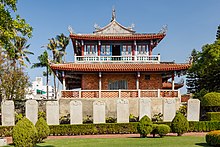Fort Provintia
Fort Provintia ( Chinese 赤嵌樓 , Pinyin Chìkǎnlóu , Pe̍h-ōe-jī Chhiah-khàm-lâu , often written Chihkan ) is a historic building complex in the Zhongxi district of the southern Taiwanese city of Tainan , which dates back to 1653 at the time of the Dutch colonization built fortress goes back.
history
After the suppression of an uprising by Chinese immigrants, the Dutch East India Company decided to build another fort in addition to its Fort Zeelandia base, which had existed since 1624, to stabilize its control over southern Taiwan. The fort, completed in 1653, was named Provintia and was located a little more than three kilometers north of Fort Zeelandia. With a crew of 500 men, Provintia was the smaller fort and, in addition to its military purpose, also served as an administrative center. After the invasion of Taiwan by Zheng Chenggong , the commander Valentyn had to hand over Fort Provintia to the Chinese on April 4, 1661. The following year, the Dutch had to withdraw from Taiwan entirely. Fort Provintia was renamed Dongdu Mingjing ( Chinese 東 都 明 京 , Pinyin Dōngdū Míngjīng - "Eastern Ming Capital").
As a result, Fort Provintia was initially the administrative seat of the Kingdom of Dongning , which was ruled by Zheng Chenggong and his heirs, but after its conquest by the Qing dynasty in 1683, the fort was only used as an ammunition depot and fell into disrepair due to the effects of typhoons and earthquakes. In addition, the remains of the fort were used as building material for other purposes. In the second half of the 19th century, the Haishen Temple, the Wenchang Pavilion, a private school and two shrines were gradually built on the site of the fort.
During the Japanese rule of Taiwan, the buildings on the site were used as a hospital and student dormitory. After the Second World War, the site served as a history museum and was renovated several times, giving the place its current appearance. In 1983, the Taiwanese government declared Fort Provintia a first-rate historical attraction.
The Chinese name of the fort comes from the word Sakam , a place name of the native Taiwanese people who originally lived here .
Today's appearance and usage
Due to the long period of decay and the many later additions and alterations, only a few remains of the wall of the original Dutch fort are still visible. The style of the existing buildings today is traditionally Chinese. Inside the main tower and in the side buildings there are now exhibitions on the history of the city of Tainan with a focus on the era of Dutch colonization. The site is a popular tourist destination and is open to visitors all year round. Tours in different languages are offered for groups of visitors.
The nine turtle steles
In front of the main building there are nine stone steles that rest on the back of stone turtles. Their inscriptions, written in Chinese and Manchurian , commemorate the suppression of an uprising by the Qing government in 1786. The stelae originally stood near the southern city gate and were transferred to the site of Fort Provintia in 1960.
Web links
Individual evidence
- ^ Caroline Chia: Hokkien Theater Across The Seas: A Socio-Cultural Study . Springer-Verlag, 2019, ISBN 978-981-13-1834-4 , chap. 3 Across the Seas, p. 38 , doi : 10.1007 / 978-981-13-1834-4 (English).



